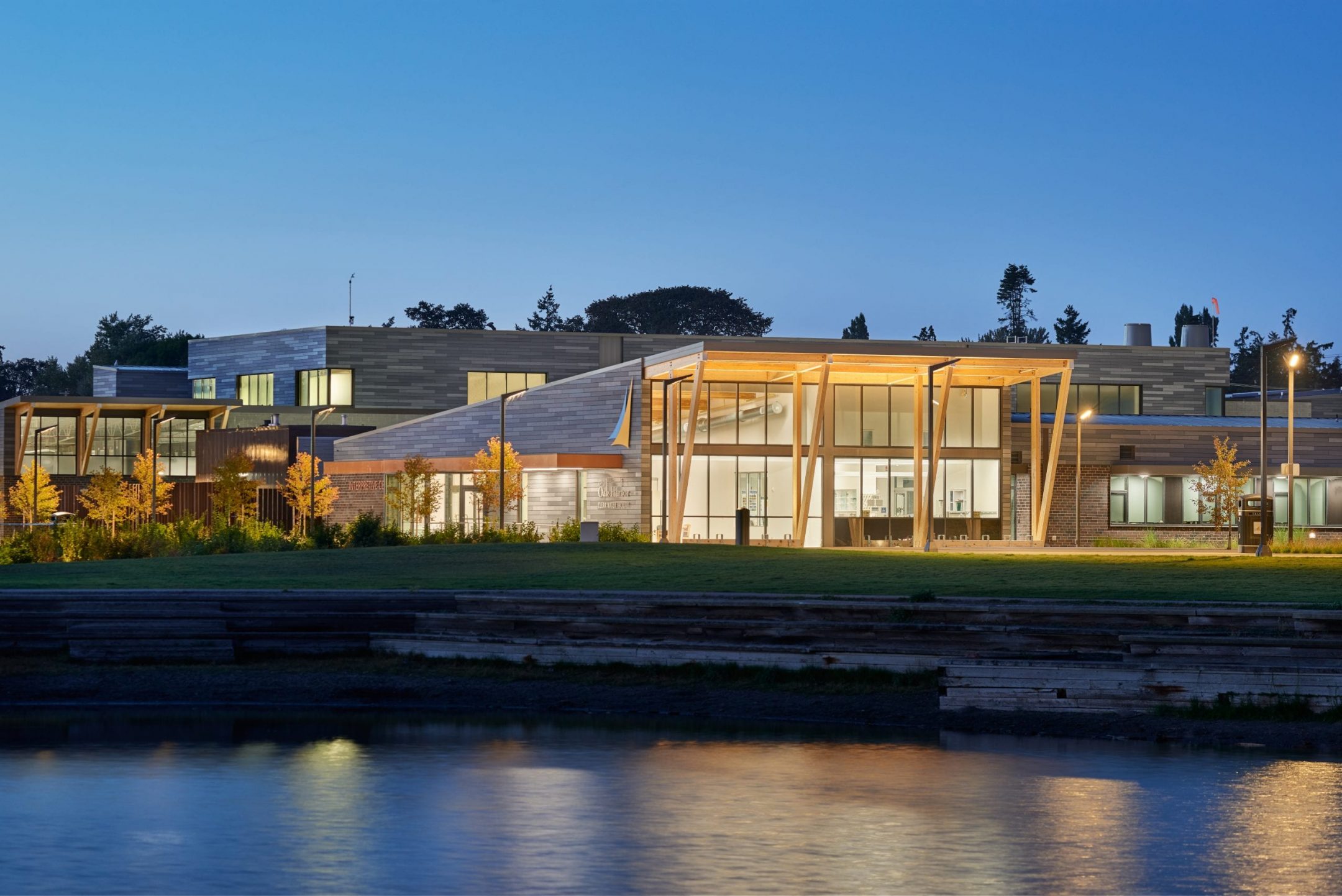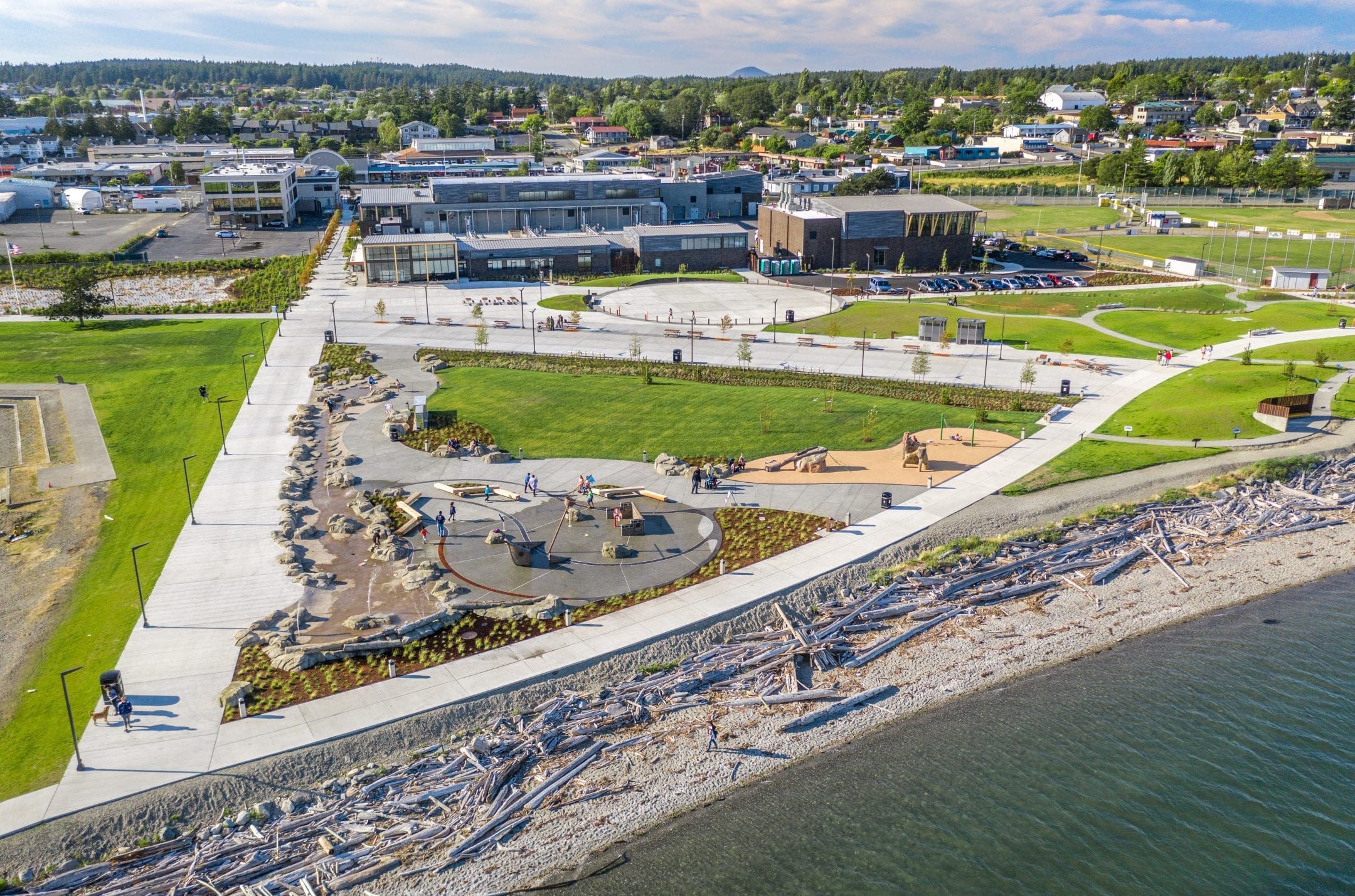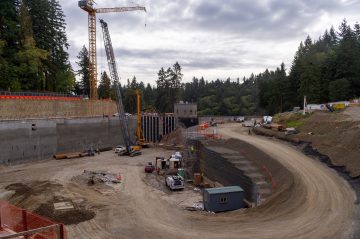Seamlessly Blending a Clean Water Facility into the Community While Delivering Capacity, Reliability, and Performance
Oak Harbor Clean Water Facility
Hoffman replaced two aging wastewater treatment facilities with a new plant that features state-of-the-art technology to provide modern standards of capacity, reliability, and performance, while protecting the sensitive surrounding environment.
Facing projected population growth and two aging sewage treatment plants with equipment failures, the Oak Harbor community needed a new facility to meet modern performance standards but was also adamant about protecting the environment. The new plant uses UV disinfection, which eliminates shipping of chemicals and keeps harmful byproducts out of the environment. The team worked in seismically unstable ground, below grade and in water, while managing the mass excavation of 50,000 cubic feet of soil.
The area was also rich in artifacts, including some human remains. The project was built in phases to accommodate the archaeologically sensitive site conditions and keep portions of the plant in service throughout construction, and the team went above and beyond to work with community members to ensure minimal disruption to the island residents. The scope included 12 buildings encompassing 70,200 SF occupied and 93,200 SF gross, plus transformative improvements to Windjammer Park.
The new plant, certified LEED Silver, has a 50-year lifespan.
Challenge
How can the use of Heavy Civil GC/CM contracting reduce risk for the City while addressing an aggressive schedule and strict environmental considerations?
Solution
The project was built in phases to accommodate archaeologically sensitive site conditions and keep portions of the plant in service throughout construction, while extensive community outreach ensured minimal disruption to residents. The team made extensive use of 3D scanning to develop an effective approach for work in seismically unstable ground, below grade and in water. The mass excavation encompassed 50,000 cubic feet of soil.
-
2020 Excellence in Engineering Award — American Council of Engineering Companies - WA Chapter
2020 Award for Engineering Excellence — ACEC National
2020 Grand Award — Washington Association of Landscape Professionals
2020 Best Project - Water/Environment — Engineering News Record - NW
2019 Project of the Year - Environment — American Public Works Association, National
2019 Project of the Year - Environment — American Public Works Association, Washington Chapter
2019 Excellence in Concrete Construction Awards — Washington Aggregates and Concrete Association
2019 Excellence in Masonry Awards - Government and Public — Masonry Institute of Washington
2019 Award for Innovation and Achievement in Sustainability — Northwest Construction Consumer Council
2019 Recognition for Innovative and Sustainable Water Infrastructure — US Environmental Protection Agency

Clean Water Facility Construction Protected Critical Habitat
As part of the siting evaluations, critical areas studies were conducted. The project occurs within 200 feet of Oak Harbor, and a wetland was delineated along a portion of the northern boundary of Windjammer Park. Thus, the facility’s design had to account for the wetland, and direct wetland impacts had to be avoided entirely. Wetland buffer impacts were, however, unavoidable. The wetland is a linear feature approximately 1,000 feet long with a mowed lawn buffer on the south side and pavement along the north side. The mowed lawn area to the south provided limited functions to the wetland, and the pavement to the north was non-functioning as a buffer.
To enhance the functions and values of the wetland and buffer, a stormwater feature was constructed adjacent to the existing wetland to provide a more natural appearance and additional habitat area. The southern buffer is also being enhanced with native vegetation plantings. Monitoring will be conducted for a period of five years to ensure that the vegetation is surviving and performing as intended.
Appropriate best management practices (BMPs) were used for pollution, sediment, and erosion control during construction. Erosion and sediment control measures included mulching, matting, and netting; filter fabric fencing; quarry rock entrance mats; sediment traps and ponds; and surface water interceptor swales and ditches. Using these BMPs minimized sediment transport, thus protecting water quality in the wetland and Oak Harbor, and ultimately protecting critical habitat.
Heavy Civil GC/CM Mitigates Construction Risk
The heavy civil GC/CM provisions — the first issued in the State of Washington—allowed for negotiated work between Hoffman and the City. The City used this negotiated work to accelerate the construction of the treatment structures. The concrete construction involved extremely complex geometry, specialized mix designs, and extensive mechanical and electrical penetrations. Trying to competitively bid this work in a single package would have had high potential for expensive changes, delayed the project for at least six months, and proven difficult to coordinate other phases of the work.
Concrete packages were split into three construction phases, all performed on a time and materials self-perform basis. With this approach, specific elements could be started as final designs became available. Design changes between phases were incorporated on a time and materials basis using the negotiated prices. To ensure work was completed efficiently and on schedule, specific productivity goals were used throughout the project. This approach allowed for an aggressive schedule, cost-efficient construction, and a much higher quality of workmanship.
The later concrete phases involved more extensive piping and electrical coordination. Since concrete construction had started prior to bidding these subcontracts, the ability to coordinate new subcontractors after construction started helped minimize spatial conflicts. The new subcontractors incorporated their penetrations into the ongoing activities seamlessly.
Meeting an Aggressive Schedule
Completing the project on schedule was a complex task due to site constraints, technology requirements, political interface, environmental issues, and funding availability.
The Oak Harbor site was highly visible to the public, had substantial geotechnical considerations, and was a known archaeology site. If conventional design-build had been used, it would have added 18 to 24 months to the schedule and prevented risk mitigation. Our project team established a best value schedule and managed the design, procurement, and construction processes to successfully complete the project on an aggressive schedule and meet the milestone goal for substantial completion of the project.
Getting the project started in an aggressive manner saved the City money. Construction prices were stable in the first two years of the project but then ballooned in late 2017. At the time these escalations occurred, the project was 80 percent bought out. While the timing of the project start was partially luck, procurement delays of six months would have resulted in over $10 million in cost increases. The overall budget was maintained in a red-hot construction market.
Site Construction Challenges Overcome by the GC/CM Team
The project is located on Oak Harbor, which contains federally listed fish species, including Coastal-Puget Sound bull trout, Pacific eulachon, and green sturgeon, as well as bull trout and green sturgeon critical habitat. Throughout the project’s planning and construction phases, environmental considerations were accounted for and are described below.
The GC/CM construction team addressed numerous construction challenges resulting from the required treatment facilities and selected project location. From constructing the outfall in Oak Harbor to opening the effluent valve to discharge treated water, the GC/CM team rose to every challenge throughout construction to deliver the Oak Harbor Clean Water Facility on time and on budget.
In-Water Work
The initial work performed on-site was retiring and replacing the existing outfall line to the bay. Replacing the outfall line posed unique challenges from a construction and management perspective. Variable tides, based on the time of day and month, forced work on the tide flats during low tides, and off a barge during high tides once work progressed into deeper waters. Hoffman performed this work while always being conscientious of the surrounding public and environmental protection. Large, wood crane mats were used to move heavy civil equipment on the tide flats while reducing the environmental impact of the work.
The challenges of this portion of work extended to safety and extensive pretask planning concerning divers and workers. Dives were planned and walked through weeks in advance and revisited before the work was performed to ensure a safe and efficient installation.
Groundwater Management
The location of this project and proximity to Oak Harbor posed significant concerns about groundwater prior to mass excavation. The Clean Water Facility is located approximately 100 yards from the shores of the bay, with groundwater found at Elevation 7.0 and excavation extending to Elevation -13.5. To combat the groundwater, the project employed locking sheet piles driven into glacial till to form a cofferdam. The quality of the cofferdam installation resulted in relatively minimal groundwater infiltration that was readily dealt with and treated on-site.
Mass Excavation
Over 50,000 cubic yards of soil was excavated from the newly formed cofferdam. Looking forward at upcoming work in the adjacent Windjammer Park, the team decided early on to keep this material on-site to avoid the added costs of haul-off and new import when the time came. Fortunately, an expansive laydown yard had available space to stockpile this material. During the Windjammer Park work, all this material was used to recontour the park and raise the overall elevation throughout to alleviate flooding.
Crane Placement
During construction, multiple buildings spread across the two+ acre site had to be accessed. By correctly positioning a tower crane, the project was able use one large tower crane instead of multiple cranes. The crane was strategically located so it would be of use throughout the project while not impeding the construction progress. In addition, the crane had to be placed within the confines of the cofferdam due to ground loading restrictions.
To allow for timely backfill of the structure inside the cofferdam, Hoffman used a 20-foot concrete retaining wall to isolate the crane from the surrounding backfill. The Oak Harbor Clean Water Facility is located adjacent to SE City Beach Street, which was lined with above-ground power/communication lines on utility poles. With the larger crane radius, Hoffman decided to move these utilities underground to eliminate any potential hazard of crane contact and to leave the project with a “cleaner” look upon completion.
Jobsite Location
Transporting materials and recruiting qualified workers to Oak Harbor’s remote location posed many challenges. There are only two ways on or off the island: one is taking the Mukilteo/Clinton ferry and the other is driving across the narrow Deception Pass bridge. One challenge was bringing large loads (e.g., a tower crane) over the bridge. This required coordinating with the Department of Transportation and bringing equipment over the bridge during select hours that correlated with low traffic times. Regarding the workforce, the project was fortunate to be able to use as many local contractors and local workers as feasible.










